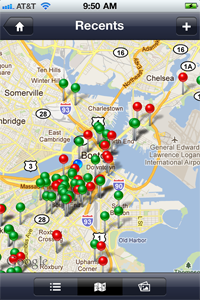Boston’s City Hall Could Be Award-Winningly Innovative
This morning, the Ash Center for Democratic Governance and Innovation at Harvard’s Kennedy School announced the 25 finalists for their annual awards in Innovations in American Government. Among those recognized were a health and wellness program in Washington, a federal neighborhood revitalization initiative, and San Francisco’s supply-and-demand parking (a system I suggested that the city of Boston adopt this past November). But the nod that caught our eye, naturally, was the one bestowed on our Mayor’s Office of New Urban Mechanics, the tech whizzes behind the Citizens Connect and Street Bump apps.
Coincidentally, we have a great story in our current issue by Chris Faraone on the New Urban Mechanics, which is led by Chris Osgood and Nigel Jacob. Here, Faraone describes Citizens Connect:
Now, users can simply point their phone at a public hazard or eyesore and snap a picture. The image—along with corresponding GPS coordinates—is then routed to the appropriate department in City Hall. The MONUM was officially born soon after, in 2010, with Osgood and Jacob appointed as cochairs. The office continued to improve Citizens Connect, and today users can report problems by phone, text, or tweet.
These developments are a big change from years past, when calls to City Hall bounced among operators until complaints wound up scribbled on a pad somewhere and seemingly went ignored. This new approach is often called participatory urbanism, and it’s unfolding in every realm of Boston city services, from transportation to trash collection.
It’s worth a read in its entirety—and makes clear why the Ash Center recognition was so justified. The Ash Center’s reasoning for citing Boston’s efforts was pretty short—”[The office] offers an approach to civic innovation focused on delivering transformative city services to residents”—so I called up Stephen Goldsmith, the center’s director, to hear more.
“I’ve seen few things that have caught the imagination of mayors across the country more than the Boston Mayor’s Office of New Urban Mechanics,” Goldsmith says. (And he ought to know; he’s a former mayor of Indianapolis.) “Although I wasn’t one of the judges, the first thing that caught my eye is the impact they’ve had already; the second is the quality of people involved. And I think the breadth of what they’ve done is impressive.” To wit: Philadelphia has started its own New Urban Mechanics office, while other cities have launched their own versions of some of the apps.


